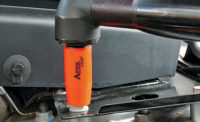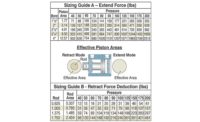An understanding of how the tool operates, how to properly maintain the tool, and proper application of the tool is essential to ensure the safety of the operator while using a DC electric fastening tool. Some of the driving factors to ensure safe DC electric torque tool uses are covered in the following article.
Expect torque reaction
DC electric direct drive tools can exert high amounts of torque on a fastener. In turn, that torque must be held by an operator or a reaction device on the tool. When a tool is operated, ensure that the operator understands the direction of expected torque, this can prevent injuries if the operator is prepared to resist the torque reaction. When possible, a reaction device should always be used. Depending on the type of tool, for example inline tools, at even very low torque, tools may cause injuries if the operator is not trained and prepared. STANLEY Assembly Technologies has designed and developed many reaction devices to reduce this danger for operators.
Protect yourself
Wearing the appropriate personal protective equipment is essential to ensuring the safety of the operator. If the socket of the DC electric tool is not covered or protected, do not wear gloves near these rotating components. The glove could become twisted in the end of the tool causing potential harm. STANLEY offers pinch protectors and rubber output protectors for the end of our handheld tools for an extra layer of safety.
Unintentional operation
When handling a DC electric tool, sometimes a trigger can unintentionally be activated posing a safety concern for operators. STANLEY has recognized this safety concern and offers a few features to reduce this concern. STANLEY offers a two-hand anti-tiedown accessory, which is a kit that requires two buttons be pressed simultaneously to start the tool. In some cases, two-hand operation is not an option, in that case, another method to prevent unintentional operation is by disabling the tool when the rundown is complete or adding a delay between trigger pulls. These two setup options are enabled in software and allow the operator to use the tool as needed and disables the tool during the tools down time.
Tool Shock Hazard
In the manufacturing environment, DC electric tools and cables will eventually become worn. If this happens, bare wires or frayed ends may be present. Never operate a tool with a defective cable and replace cable(s) if there are any visual damages. Reviewing cable wear should be an inspection step before the use of any tool. Always protect cables from premature wear by avoiding contact with sharp edges, solvents, and heat.
Tool Selection and Care
Eventually all DC electric tools require preventive maintenance and/or repair. When working on a tool, always follow the manufacturers recommended procedure and follow the recommended preventive maintenance intervals to ensure the operators are using safe, well maintained tools. STANLEY has certified repair centers across the world that are required to attend a repair training every year to maintain their certification and can assist with preventive maintenance and repair and are always willing to help with quick turnaround times.
Expect the unexpected
When working in a fast-paced manufacturing environment, safety can sometimes be forgotten. Always plan for the unexpected. Ensure that a full safety assessment is completed prior to allowing tools to be used in mass production. STANLEY offers a product training, in which programming safety, tool handling safety, and reaction device safety is covered. Contact Stanley for details.
For a free Stanley Safety or Stanley Tool Exploded View Poster, for more information, setup a demo, or inquire about training, please contact STANLEY Assembly Technologies using the email SatInfo@sbdinc.com





